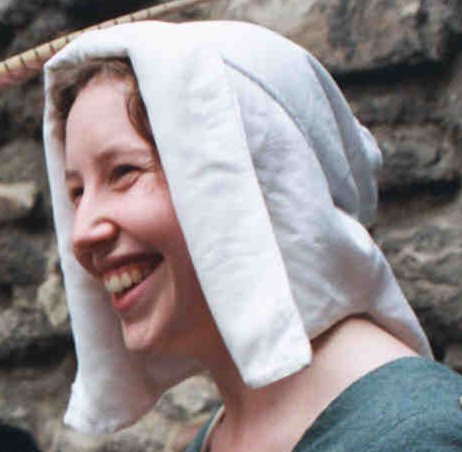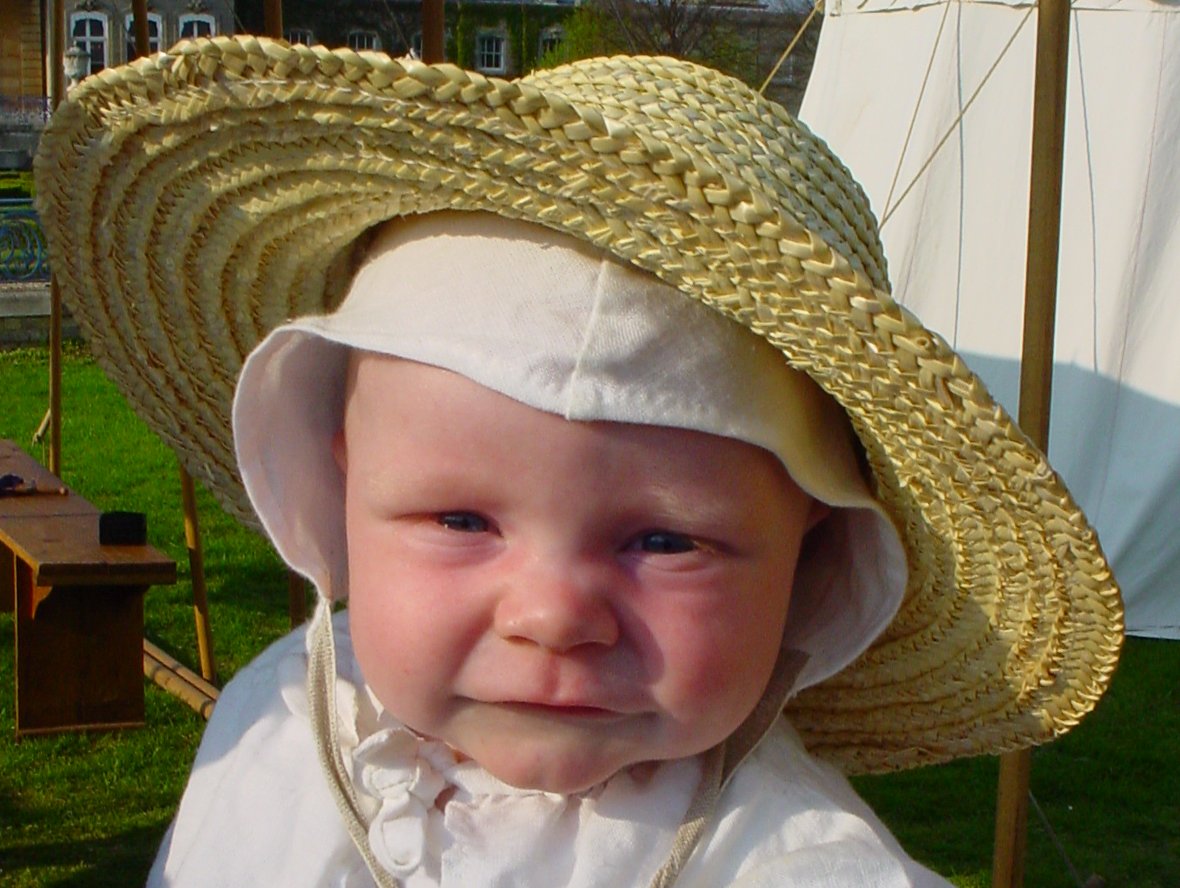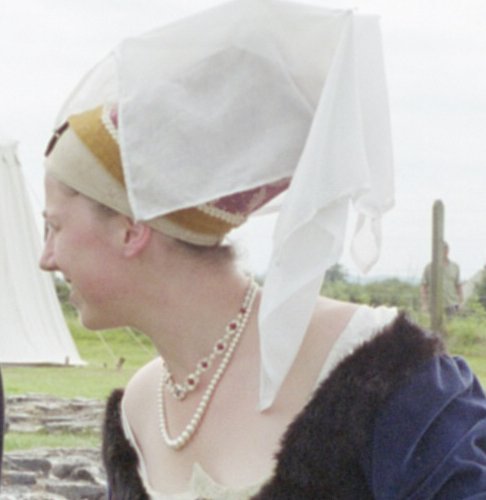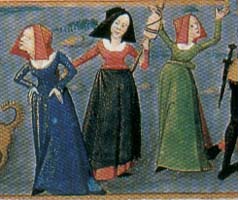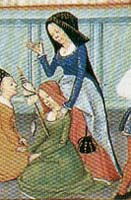Basic Head dress
A Guide to Hairstyles and Hats for Females
This guide is for those War of the Roses Re-enactors who wish to get their head gear to match their dress as well as the task in hand. The ideal would be for us all to have long flowing locks that reached past our waists, which could be neatly plaited and coiled onto our heads, with hats placed on top and pinned or tied into place. Yeah right matey! As this is generally just an ideal, we’ve tried to be sympathetic to modern hairstyles as not all of us wish to, or are able to, grow our hair long! There is always the danger of re-enactors fringe by the end of the day; where hair has been scraped back all day under your hat and is now sticking up in a tuft at the front, and nothing short of washing your hair is going to make it sit right!
Female re-enactors generally fit into five groups;
-
Children, preteens and teenagers
-
Those dressed for dirty jobs around the camp such as cooking, nursing etc as well as their camp duties.
-
Those more respectable ladies dressed in gowns, dressed for sewing, music etc
-
Minor nobility and above, i.e. those in posh kit
-
Cross-dressed for battle/working with and riding horses
Each has it’s own style of hair and headdress and it’s quite important to try to get the look right: for an extreme example, a steeple hennin does not look right with a basic kirtle and apron, nor does a simple linen hat go quite right with a court style gown. Hopefully the following guide will give us all ideas as to how to match things up, on new styles and colours, veils etc. Also, when pinning a hat, try to use authentic pins suitable for your status. I’ve also added modern ‘cheats’ that I’ve found help. If you think anything below is wrong or have further information, please contact the group and let us know; we are always willing to learn!
Children, preteens and teenagers
Babies and Toddlers. As babies, children were generally wrapped in swaddling, which included their head. Modern thinking doesn’t necessarily agree with this, and it makes it awkward for changing nappies! Instead, babies are often dressed as toddlers would be, in long shifts and gowns. Obviously this doesn’t cover the head. Illustrations of the time seem to favour coifs, a soft linen bonnet-like cap that fits to the head. This protects the head while the natural fabric lets the skin breath. During the summer a straw hat (preferably with a stiff brim) can be worn over the top, if the little darlings will tolerate it!
Preteens. In medieval times youngsters were seen as children until the age of eight, when those not being schooled would start working. Girls would generally wear their hair uncovered; unbraided loose long hair was a sign of virginity and purity and highly fashionable. If your youngster has long hair, then leaving it uncovered is fine, hair can be held off the face with a fillet (a type of alice-band) and/or braided.
If she is sporting a haircut that finishes above the shoulders then there are a few options; if it’s all one length then leave it uncovered, a child who was ill or had contracted some sort of lice would often have their hair shorn, so the short haircut can be explained this way. The other option is a linen coif on girls under 5, or a copy of the simple linen hoods. (These can also be worn with long hair, although it’s advisable for the hair to be braided underneath). The linen hoods are generally worn with a fillet and come down over the neck, useful for girls with fair skin as it will protect from sunburn and it’s easy to stick a straw hat over the top!
|
ILLUSTRATIONS
|
Teenagers and those over 8 years old. During the medieval period children over the age of 8 were expected to be miniature copies of their elders. If the girl's kit is just a kirtle then a linen cap or hat is suitable, with the hair braided and caught up inside. If she is wearing a gown, then either a linen hat or a truncated hennin is suitable. However, for those not trying to emulate those older than themselves and wanting to go off to play, this isn’t going to work. The hennin inevitably is going to be taken off and lost somewhere! The best bet is to see what the youngster prefers, and again in the summer, straw hats with wide brims are a must!
If the lass is older then she’ll probably be as fashion conscious about her medieval kit as her modern clothes. Her standard of dress and the standing of her family around the camp will designate what type of hat is suitable, so the next few groups are her best reference.
For all children, travelling hoods are recommended for cold weather and wide brimmed straw hats for sunny weather. These are both mentioned in the next section. On children we recommend sewing bells to the end of a liripipe of a hood or the ribbons of a sun hat… helps locating the little tearaways!
For those dressed in kirtles.
For those of us who seem to run round the camp all day doing the dirty jobs we don’t want our hair getting in the way, and for the medieval woman there was the added disadvantage of any hair showing was a sign of loose morals. Therefore some type of linen hat is a good idea. There are a number of types that I shall discuss below. Please remember though, loose weave material is semi transparent so short hairstyles are more noticeable, especially if the hair pokes through the fabric, also dyed hair in unnatural colours can be seen, as the colour will show through.
The muslin wrap. Muslin is currently a cheap material and made of cotton, though if you can fine linen muslin that would be preferred. The wrap is excellent for any hairstyle as it can be tied in a number of different ways and will cover the hair entirely. You start with a rectangle of muslin, preferably hemmed along the raw edges by hand. The short end of the rectangle must be long enough to fit around your head like a headscarf and tied at the back. From here there are a number of styles.
Tie the other short end the opposite way round your head so the tied ends are above your brow. The loose triangular flappy bits can either be tucked in underneath or pinned attractively to the sides or crown. If you have long hair you can leave it loose to catch in the ‘bag’ and the style is flat enough to plonk a straw hat over the top! If you make the rectangle long enough the ‘bag’ will cover your exposed neck at the back.
|
ILLUSTRATIONS
|
At the nape of the neck start twisting the excess fabric (and hair if your's is long enough, ensuring it’s completely covered) in a clockwise direction. From here you have a choice of two styles. The first is to twist the fabric over your temple and forehead, back down over the other temple and securing at the nape of the neck by looping round the start of the twist and tying in place. Try not to get this style too tight as it can cause headaches, or twisting it too loosely as it will all come undone. The second is to keep twisting at the back of the neck until the fabric coils up itself and you can’t twist it any further (be careful if you have long hair as this can hurt). Coil the fabric round itself into a bun shape and secure it by tying it on itself or pinning in place.
|
ILLUSTRATIONS
|
This style also means you can pin linen kerchiefs over the top to make it look more fashionable. If you like this idea it’s wise to experiment with a mirror at home to get the look and feel right. Show a friend or partner when you have the required look, as they may have to help you achieve it when the mirror has gone missing or isn’t big enough!
Linen kerchiefs. The other option for pinning linen kerchiefs is using a fillet. If you have short hair it is recommended to pin the bottom of the kerchief to the bottom of the fillet, as when you lean over your hair can become exposed. If you have long hair and don’t want it to bother you, use a hair net to keep it up, then you can either leave your hair loose or plait it and tuck it into the net. I’ve cheated on mine and attached the net to the fillet, and I’ve used modern hairnets, the thicker type that can be found in most supermarkets or chemists. If you want to be authentic you could try making your own hair net and attaching it. I’ve found that the net keeps the hair off the back of my neck (great when it’s hot) and it gives you something to pin your kerchief to.
|
ILLUSTRATIONS
|
Linen hats. These need securing to a fillet, otherwise they are likely to fall off! There are a number of simple, effective designs that are quite attractive; such as the extended semi-circle and the unusual one with the flap that is pinned onto the crown, as featured in Sarah Thursfield’s book, the Medieval Tailor’s Assistant. There is also a hood with a liripipe as seen in many continental sources, where the turn back around the face seems to be quite pointed. There are 2 more well known types: the ‘rabbit’s ear’ hat that sports long pieces which hang down the back of the hat and get taken round the front and tied, the ends looking like rabbit’s ears; and the later version where the ears have become thicker and hang down the back of the neck. This style is similar to a later, more upmarket, style and was probably worn well into the early Tudor period. For a later fifteenth century style that was also worn into the Tudor period, a very simple version of the gable head dress can be found in Sarah Thursfield’s book, the Medieval Tailor’s Assistant.
|
ILLUSTRATIONS
|
Simple hoods as a general rule are spot on, but be careful of making one that is from a later period; like one made with a simple band over the forehead and temples, with a gathered circle covering the rest of the hair, and mob caps are definitely not right! There are many illustrations of a turban style headdress. While being absolutely correct, the style is mostly Germanic in origin and was not really worn in Britain, unless by the wife or widow of a travelling merchant. These are easily spotted by the coloured fringing worn at the nape of the neck and are beautifully shown in literature by the Company of St George and Gerry Embleton.
Straw hats and Travelling Hoods. These things are a godsend and are two of the few unisex pieces clothing. In the height of summer, or even on a very bright day, pop your straw hat on and shield your eyes from the glare and keep the sun from burning your skin. The wider the brim the better. Some authentic designs have unusual shaped crowns that can still be found occasionally. Straw hats can be accessorised, great if you have a large number of hats in one area. Using ribbon (preferably linen, nothing shiny), feathers or thread you can decorate your hat to the style you like. By stitching the ribbon in place you know you’re not going to loose it and brightly coloured ribbon can be used instead of cord or string to keep the hat on your head. If the brim starts to fray, (or even before) you can put some decorative stitching on to keep the edge strong and tidy, if you get a hole in your hat you can always cover it. A prime example is my sun hat that got an arrow through the brim at a siege. Rather than throw it away I covered it with pheasant feathers. Okay, so it’s nickname is the pheasant caught in a tumble dryer but it looks fabulous and everyone recognises it, even if they don’t recognise me!
Travelling hoods are excellent for evenings and cold weather. Most fashionable with a liripipe, the skirt of the hood coming down over your shoulders is great for keeping that nippy draught off your neck. The liripipe, rather than being tucked in your belt, can be used as a scarf to keep the neck nice and snug. Usually worn with a linen hat or muslin wrap, they can be of any colour, usually fastened with buttons and can be long enough round the face that when done up it protects the face from any side wind by coming past the nose and fastening under the chin. When undone this can be turned back. Hoods can also be trimmed or lined with fur for that extra bit of wind protection. (Hoods are also useful for playing hoodsmans’ blind, an early form of blind man’s buff; a group of you have travelling hoods, one wearing theirs back to front, undone with the liripipe securing it round the neck. The one is spun round a few times and the rest flick them with their hoods. Whoever is caught is the next one to wear it back to front…this is a great game for during the day, especially if there are children to join in. We don’t recommend this game to be played at night, as you never know what you could fall over).
For those dressed in gowns
There are a number of ways a well-dressed woman can wear her hair and her hat. Contemporary illustrations show us that these women even kept their hair covered while taking a bath, although this maybe to stop them getting their hair wet. Pictures and portraits from the period more readily show the styles of the merchant and middle class families. Hair was generally plucked to expose a high generous forehead with the hair hidden under a hat or hood. Unless the woman in question was a maid, or it was her wedding day, the hair was always covered. There are illustrations of women with their hair uncovered and worked into braids, coils and ropes, but these are mainly of Mediterranean origin. Although the weather is now generally much warmer in the summer than it was in the fifteenth century, we would recommend sticking to northwest European styles from Britain, France, Burgundy and Flanders.
Linen and Wool Hats. Linen hats as those described above would be worn in the home. A modern day equivalent is slippers, worn inside the home to be comfortable in. Wool hats were very similar in style and shaped into hoods.
Hennins. Truncated henins were very popular throughout the second half of the fifteenth century. A truncated henin looks like an upturned flowerpot. The current theory is the Henin was made of leather formed into a cone (without the point) and the sides laced together. A cover would be made to fit over the top to correspond with your dress. There are contemporary pictures of women visiting shops wearing henins with simple veils over the top. After trying many different fabrics the closest to those shown in the portraits seems to be that of silk voile. Silk chiffon is not transparent enough and the silk voile seems to have the stiffness required for the folds and creases seen in the portraits. Please don’t use modern synthetic fabrics as these have a different sheen to them and can be spotted a mile off. Although the voile is quite expensive, it’s worth splashing out on, it hand washes and irons well and looks so much better.
If you feel that you wouldn’t have been able to afford the silk needed for a veil, don’t worry. There are also many pictures and portraits of women not wearing veils. Having worn them, unless you are inside, they do have a tendency to get in the way and catch the slightest breath of wind. It’s very difficult to be ladylike when you’re trying to talk with a mouthful of silk voile that keeps blowing back into your face.
